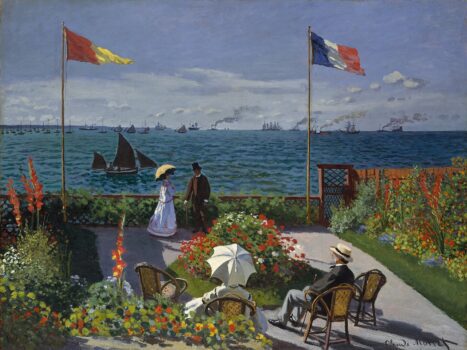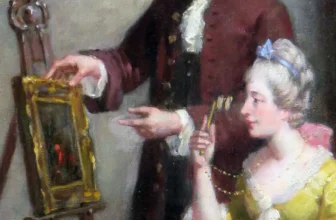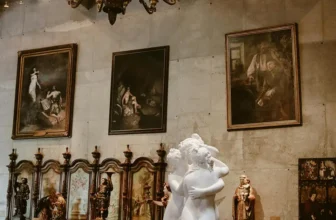A Deep Dive into Claude Monet’s Garden at Sainte-Adresse Painting
Shopping Ads: Antique Oil Paintings On Canvas For Sale. Limited Originals Available 💰😊
Authentic hidden masterpieces, Explore old master antique oil paintings from the Renaissance and Baroque eras. From 15th-century to 18th-century Antique Paintings. Bring the Renaissance and Baroque in your home. Shop Now!
🎨 Antique Oil Paintings On Canvas Renaissance, Baroque Art Antique Oil Paintings, Make Offer 16th to 18th Century Portrait Paintings
Claude Monet’s Garden at Sainte-Adresse (1867) stands as one of the earliest masterpieces of the French Impressionist movement, predating the official birth of Impressionism by several years. Though not as popularly cited as his later works, like Impression, Sunrise or the Water Lilies series, Garden at Sainte-Adresse is an immensely rich painting that reveals much about Monet’s development as an artist, the social and political context of the time, and the subtleties of human relationships embedded in landscape art. This post explores the visual narrative, symbolism, stylistic significance, and current home of this iconic painting, with a comprehensive analysis that uncovers the layers of meaning within its deceptively tranquil surface.
What Is the “Garden at Sainte-Adresse” All About?
Painted in 1867 during a summer stay with his father in the seaside town of Sainte-Adresse near Le Havre, Normandy, Claude Monet’s Garden at Sainte-Adresse captures a moment of serene domestic leisure. The canvas, executed in oil and measuring 98.1 × 129.9 cm, presents a lush garden scene overlooking the English Channel. A small group of bourgeois figures, two seated, one standing, and one strolling, occupy a sunlit terrace adorned with flowers and bordered by a white balustrade. Two tricolor French flags flutter in the wind, while steamships sail in the distance under a bright, partly cloudy sky.
The overall composition is serene and ordered, but beneath its visual harmony lies a layered narrative, full of social commentary, personal tensions, and proto-Impressionist experimentation.
Monet’s Early Exploration
By 1867, Monet was still relatively unknown and financially unstable. This summer visit to Sainte-Adresse was partly a retreat and partly a means of reconciling with his disapproving father. At the time, Monet’s lover, Camille Doncieux, who would later become his wife, had just given birth to their first child, Jean, in Paris. Interestingly, Camille and the baby were not included in this depiction of Monet’s family gathering, perhaps revealing a poignant personal exclusion and tension between Monet’s personal desires and familial expectations.
Monet created several paintings during this stay, including Terrace at Sainte-Adresse, which depicts the same location from a slightly different angle and with a different tonal quality. These works signaled a transition from the Realism of the Barbizon school to the luminous brushwork and open compositions that would come to define Impressionism.
What Is Happening in the Painting?
On a superficial level, the painting appears to show a peaceful summer afternoon on a seaside terrace. Four figures are visible:
A seated older man with a straw hat – Believed to be Monet’s father or uncle.
A young woman in a bright white dress with red trim – Possibly Monet’s cousin or another relative.
A man standing with his back to the viewer, gazing out to sea – He is engaged in silent observation, introducing a contemplative mood.
A female figure walking in the garden, only partially visible, which adds a sense of casual movement and life.
The garden is resplendent with blooming flowers, geraniums, sunflowers, and dahlias, meticulously arranged in neat beds. The composition is carefully organized, with the lines of the balustrade, parasols, and flagpoles leading the eye toward the horizon, where ships traverse the calm sea.
Monet’s use of vibrant, sun-drenched color captures not only the light but also the airy atmosphere of seaside leisure. The figures are absorbed in their own worlds, and there is little interaction between them, adding an emotional distance and quiet introspection to the scene.
Symbolism and Interpretation: Beneath the Surface Calm
Though the surface of the painting is tranquil and seemingly apolitical, deeper symbolism pervades the canvas.
1. The French Flags
The most overt symbols are the two tricolor French flags prominently placed in the upper half of the composition. Painted just three years before the Franco-Prussian War (1870–71), these flags can be interpreted in several ways:
National pride: Their placement in a leisure scene may symbolize the blending of national identity with domestic peace and bourgeois prosperity.
Political subtlety: Painted during the reign of Napoleon III, Monet’s inclusion of these flags could also be a subtle nod to the tensions between imperialism and emerging republican sentiments.
2. The Division of Space
The physical composition of the painting suggests layers of separation:
The terrace is bounded by a white fence that creates a boundary between the garden and the vast, open sea.
The foreground with the seated figures suggests comfort and rootedness.
The background, with ships and a standing man gazing outward, suggests movement, travel, and perhaps escape or yearning.
This spatial segmentation can be read as a metaphor for Monet’s own life at the time: torn between familial duty and artistic independence, between tradition and innovation, and between a stable bourgeois identity and a bohemian one.
3. Figures and Emotional Distance
The emotional detachment of the figures is striking. They appear isolated in their own contemplations despite their proximity. This may reflect the growing alienation of individuals within the modern, industrialized world, a theme that would be explored by many artists and writers of the 19th century.
Artistic Style: Impressionism in Development
Garden at Sainte-Adresse straddles the line between Realism and Impressionism. Monet had not yet fully embraced the broken brushstrokes and fleeting optical impressions that would come to characterize his mature style, but we can already see many proto-Impressionist elements:
Natural light: The sunlight is realistically portrayed, casting sharp shadows and illuminating the garden’s vibrant colors.
Color palette: Monet uses a palette rich in blues, reds, and greens to express the freshness of the setting.
Outdoor scene: The “en plein air” depiction of bourgeois leisure in nature would become a hallmark of Impressionism.
Flatness and perspective: Despite the depth created by the balustrade and receding ships, the painting has a slightly flattened perspective that emphasizes the surface and texture of the canvas.
This painting serves as a precursor to the Impressionist movement’s concern with capturing fleeting moments and atmospheric conditions. Monet is experimenting here with how light interacts with color, how composition can guide perception, and how mood can be subtly evoked through scene and structure.
The Personal in the Political
Although the painting seems to celebrate a moment of familial and national stability, Monet’s personal context suggests otherwise. The decision to exclude Camille and baby Jean from this seemingly idyllic family scene reveals deeper tensions.
Monet was not married to Camille at the time, and his father disapproved of the relationship. The absence of Monet’s chosen family in favor of his birth family speaks volumes about the social pressures he faced. In this sense, the painting can be viewed not just as a depiction of leisure but also as a coded negotiation of identity, belonging, and artistic ambition.
Location Today: Where Is Garden at Sainte-Adresse Painting Now?
Today, Claude Monet’s Garden at Sainte-Adresse resides in the Metropolitan Museum of Art in New York City. It is part of the museum’s European Paintings collection and is displayed as a significant example of pre-Impressionist landscape painting.
Its location in one of the world’s premier art institutions ensures that it continues to be studied, appreciated, and contextualized within Monet’s broader oeuvre and the history of modern art. Visitors to the Met can experience the painting firsthand, appreciating not only its compositional beauty but also the delicate balance it strikes between tradition and innovation.
While Garden at Sainte-Adresse may not have the immediate recognition of Monet’s later works, it is a pivotal piece in understanding his evolution as an artist. It bridges the structured compositions of earlier landscape traditions with the light-infused spontaneity that Impressionism would soon embrace.
Artists like Pierre-Auguste Renoir, Édouard Manet, and Berthe Morisot also explored similar themes of bourgeois leisure, domesticity, and landscape, but Monet’s unique blend of personal narrative and pictorial experimentation in this painting sets it apart.
A Snapshot of Transition
Claude Monet’s Garden at Sainte-Adresse is more than just a beautiful seaside garden scene. It is a painting rich in visual harmony, emotional complexity, and symbolic depth. The juxtaposition of blooming flowers, fluttering flags, detached figures, and open sea weaves a subtle narrative of personal longing, social propriety, and national pride.
At once grounded in reality and suggestive of a world beyond, it marks a crucial step in Monet’s journey toward Impressionism and stands as a quiet yet powerful reflection on the human experience within nature’s vast canvas. Whether viewed as a social document, a family portrait, or a technical study in light and color, the painting remains an enduring masterpiece, one that rewards repeated viewing and thoughtful analysis.
If you find yourself in New York, don’t miss the opportunity to see Garden at Sainte-Adresse at the Metropolitan Museum of Art. Stand before it, and let its layered beauty wash over you, the sunlit terrace, the fluttering flags, and the wistful gaze toward the open sea. In that moment, you’ll not just be looking at art, but stepping into a timeless story of vision, memory, and change.




